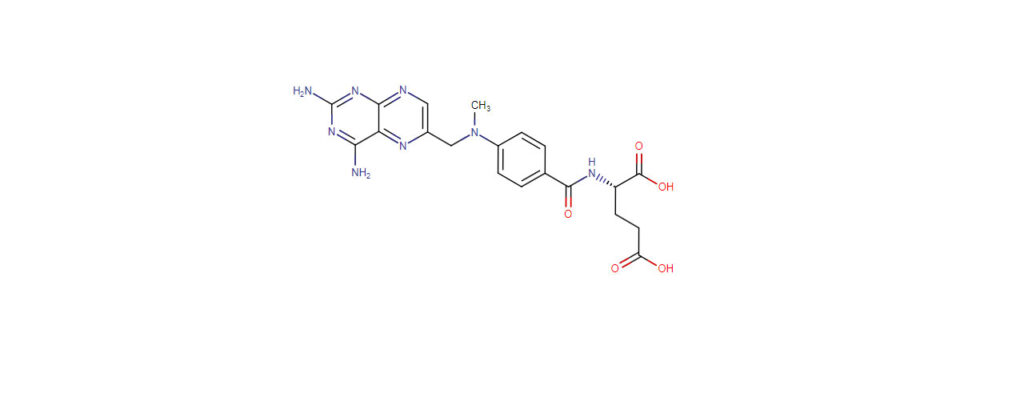
Methobel
(Methotrexate)
Composition:
ATC Code
L01BA01 — Methotrexate
Structure

Description
Methotrexate is a folate derivative that inhibits several enzymes responsible for nucleotide synthesis. This inhibition leads to suppression of inflammation as well as prevention of cell division. Because of these effects, methotrexate is often used to treat inflammation caused by arthritis or to control cell division in neoplastic diseases such as breast cancer and non-Hodgkin’s lymphoma.
Due to the toxic effects of methotrexate, it is indicated for treatment of some forms of arthritis and severe psoriasis only if first line treatment has failed or patients are intolerant of those treatments.
Indication
- Methotrexate oral solution is indicated for pediatric acute lymphoblastic leukemia and pediatric polyarticular juvenile idiopathic arthritis.4 Methotrexate injections for subcutaneous use are indicated for severe active rheumatoid arthritis, polyarticular juvenile idiopathic arthritis and severe, recalcitrant, disabling psoriasis.
- Other formulations are indicated to treat gestational choriocarcinoma, chorioadenoma destruens, hydatiform mole, breast cancer, epidermoid cancer of the head and neck, advanced mycosis fungoides, lung cancer, and advanced non-Hodgkin’s lymphoma.7 It is also used in the maintenance of acute lymphocytic leukemia.7 Methotrexate is also given before treatment with leucovorin to prolong relapse-free survival following surgical removal of a tumour in non-metastatic osteosarcoma.
Associated Conditions
- Acute Lymphocytic Leukemia (ALL)
- Acute Promyelocytic Leukemia (APL)
- Breast Cancer
- Cancer, Bladder
- Central Nervous System Lymphoma
- Choriocarcinoma
- Crohn’s Disease (CD)
- Dermatomyositis
- Disseminated Sclerosis
- Extrauterine Pregnancy
- Graft Versus Host Disease (GVHD)
- Head and Neck Carcinoma
- Hydatidiform Mole
- Lung Cancer Small Cell Lung Cancer (SCLC)
- Meningeal leukemia
- Polymyositis
- Sarcoma, Osteogenic
- Soft Tissue Sarcoma (STS)
- Squamous Cell Carcinoma of Lung
- Systemic Lupus Erythematosus (SLE)
- Uveitis
- Active Pauciarticular juvenile rheumatoid arthritis
- Advanced Alibert-Bazin syndrome
- Advanced non-Hodgkin lymphoma
- Nonleukemic meningeal cancer
- Refractory Takayasu arteritis
- Severe Psoriasis
- Severe, active Rheumatoid arthritis
Pharmacodynamics
Methotrexate inhibits enzymes responsible for nucleotide synthesis which prevents cell division and leads to anti-inflammatory actions. It has a long duration of action and is generally given to patients once weekly. Methotrexate has a narrow therapeutic index.
Mechanism of Action
Methotrexate’s mechanism of action is due to its inhibition of enzymes responsible for nucleotide synthesis including dihydrofolate reductase, thymidylate synthase, aminoimidazole caboxamide ribonucleotide transformylase (AICART), and amido phosphoribosyltransferase. Inhibtion of nucleotide synthesis prevents cell division.
In rheumatoid arthritis, methotrexate polyglutamates inhibit AICART more than methotrexate. This inhibition leads to accumulation of AICART ribonucleotide, which inhibits adenosine deaminase, leading to an accumulation of adenosine triphosphate and adenosine in the extracellular space, stimulating adenosine receptors, leading to anti-inflammatory action.
Product Information
Share This Story, Choose Your Platform!
